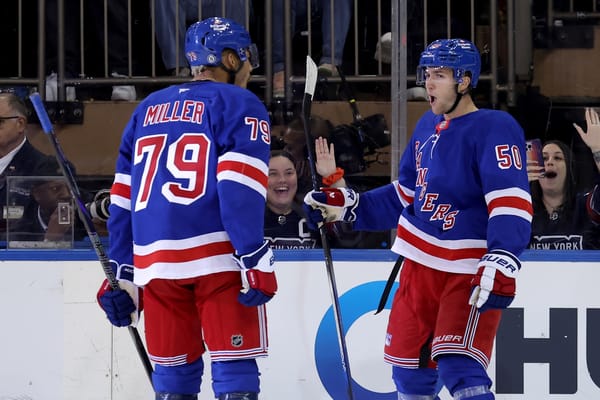Penalty Kill Perfection (Or Close to it)
The New York Rangers Penalty Kill was one of the few reliable parts during the 2008-2009 regular season. The Blueshirts led the league with a PK percentage of 87.8; allowing only 40 goals to the 329 times they went at least a man down. What made the Penalty Killing units so solid and reliable? I think it was the exact opposite of the Power Play's problem. The Rangers did such a great job with killing Penalties this past season because it had a great mix of player personnel and coaching tactics.
Now although a killed penalty can be a thing of beauty (And it is to me), not many people want to see those highlights, so I couldn't find any video on this topic. But when you look down the Rangers roster, I count at least 4 forwards and defenseman that I think everyone could label "reliable" in their own defensive zone. I've also said for the past couple of seasons that Sather is trying to build this team from the goal-mouth out, and the Penalty Kill showed us just that this past season.
Defensemen-wise, Marc Staal, Dan Girardi, and Paul Mara were the stars when it came to being a man down. Staal and Girardi were the predominant first pair for the Penalty Kill all season, and I think for their ages they did a great job. They kept the lanes clear for King Henrik, who when he saw the puck was tough to beat as usual. They cleared the puck smartly all but a few times, and always were willing to sacrifice the body. Mara was a rock on the second pairing with either Rozival or Redden, and should really not be forgotten even if he doesn't end up in Ranger blue next season.
The top Penalty Killing forwards were obviously Blair Betts and Fredrik Sjostrom, who did a great job running the top part of the diamond for the Blueshirts. To me, Betts and Sjostrom excelled this season on the man down because of their good skating abilities which allowed them to pressure the points effectively, all while protecting the coveted slot area between the dots. Ryan Callahan, Chris Drury, and Brandon Dubinsky made up the second PK unit, who followed suit behind Betts and Sjostrom with similar pressure. Callahan and Dubinsky had great years offensively, but I also thought they really grew in terms of responsibilities in the Rangers own zone. Without the emergence of those two the past two seasons, we could be looking at a playoff-less Ranger squad.
The Rangers Penalty Kill, like I said above, had a great mix of players and strategy that allowed it to flourish. Solid skating forwards along with smart, mobile defensemen gave the Rangers the whole package. Oh, and I guess we can mention that top-5 goaltender. Henrik Lundqvist cannot be under-rated by any Ranger fan for as long as he is a Blueshirt after this past season; especially some of his saves in man down situations.
But give credit where credit is due, which is due to the PK units. I have this little theory that the Rangers Penalty Kill was so good that in practice the Power Play couldn't get proper plays going because of it. Sounds crazy, right? It might, but at the same time it reminds me of my senior year in high school. We had a solid goalie and the league's best PK along with giving up the least amount of goals after the season was said and done. We ran a diamond formation like the Rangers, and being on the first PK unit (remember, I was the Blair Betts of the team), we always caused havoc for our Power Play in practice. Our Power Play was mediocre, and I really think that had something to do with it.
One can only hope the Penalty Kill can be just as good next season, as most of the key components of the man down units will be back. The Rangers swarmed opponents when down a man better than they did five on five at some points, and that can be attributed to an aggressive diamond PK strategy along with good players executing the plan. Now if only the Rangers can start scoring more shorthanded goals.




